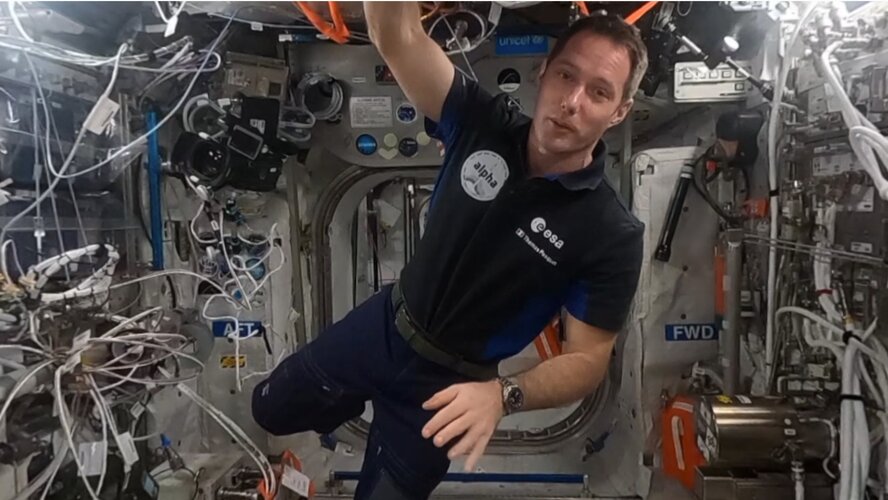
Copernical Team
Mars helicopter sees potential rover road ahead
 Ask any space explorer, and they'll have a favorite photograph or two from their mission. For Ken Farley, the project scientist for NASA's Perseverance rover, one of his current favorites is a color image of "South Seitah," an area the mission's science team had considered potentially worthy of a rover visit. The agency's Ingenuity Mars Helicopter took the image during its 12th and most recent f
Ask any space explorer, and they'll have a favorite photograph or two from their mission. For Ken Farley, the project scientist for NASA's Perseverance rover, one of his current favorites is a color image of "South Seitah," an area the mission's science team had considered potentially worthy of a rover visit. The agency's Ingenuity Mars Helicopter took the image during its 12th and most recent f Film and cultures fly on SpaceX CR23 cargo resupply mission
 Samples of the Biofilms experiment are headed to the International Space Station on the SpaceX CR23 cargo resupply mission this weekend to help maintain astronaut and material safety in space.
A common piece of advice of the past 18 months has been to make sure you wash your hands thoroughly. This is because microorganisms are easily spread across common surfaces like door handles and ligh
Samples of the Biofilms experiment are headed to the International Space Station on the SpaceX CR23 cargo resupply mission this weekend to help maintain astronaut and material safety in space.
A common piece of advice of the past 18 months has been to make sure you wash your hands thoroughly. This is because microorganisms are easily spread across common surfaces like door handles and ligh Making space-based research more affordable-with a little help from the Girl Scouts
 Using ants, plants, and even brine shrimp, a group of Girl Scouts will be among the first researchers to help test a new autonomous research platform on the International Space Station (ISS) that is helping to expand the affordability of microgravity research.
The Faraday Research Facility, developed by ISS U.S. National Laboratory Commercial Service Provider ProXopS, LLC., will launch on
Using ants, plants, and even brine shrimp, a group of Girl Scouts will be among the first researchers to help test a new autonomous research platform on the International Space Station (ISS) that is helping to expand the affordability of microgravity research.
The Faraday Research Facility, developed by ISS U.S. National Laboratory Commercial Service Provider ProXopS, LLC., will launch on StarLab Oasis opens in Abu Dhabi
 Nanoracks, the world's leading provider of commercial access to space, is pleased to announce the launch of a new Space AgTech company, StarLab Oasis. This expansion highlights Nanoracks commitment to address the growing problems of desertification, climate change, water scarcity and food security. The research on the impact of harsh space environments and arid Earth conditions on agriculture, l
Nanoracks, the world's leading provider of commercial access to space, is pleased to announce the launch of a new Space AgTech company, StarLab Oasis. This expansion highlights Nanoracks commitment to address the growing problems of desertification, climate change, water scarcity and food security. The research on the impact of harsh space environments and arid Earth conditions on agriculture, l NASA Head Nelson hopes US-Russian cooperation on ISS will continue beyond 2030
 NASA Administrator Bill Nelson has told Sputnik that he hopes cooperation between the United States and Russia on the International Space Station (ISS) will continue beyond 2030.
When asked whether he expects the ISS relationship to be extended, Nelson said: "Yes. To 2030. And Russia is our partner on the ISS".
"I'm very hopeful and very optimistic that this extraordinary relationshi
NASA Administrator Bill Nelson has told Sputnik that he hopes cooperation between the United States and Russia on the International Space Station (ISS) will continue beyond 2030.
When asked whether he expects the ISS relationship to be extended, Nelson said: "Yes. To 2030. And Russia is our partner on the ISS".
"I'm very hopeful and very optimistic that this extraordinary relationshi NASA Technologies slated for testing on Blue Origin's New Shepard
 While there won't be humans on Blue Origin's 17th New Shepard mission, the fully reusable launch vehicle will carry technologies from NASA, industry, and academia aboard. The agency's Flight Opportunities program supports six payload flight tests, which are slated for lift off no earlier than Aug. 26 from the company's Launch Site One in West Texas.
For some innovations, this is just one o
While there won't be humans on Blue Origin's 17th New Shepard mission, the fully reusable launch vehicle will carry technologies from NASA, industry, and academia aboard. The agency's Flight Opportunities program supports six payload flight tests, which are slated for lift off no earlier than Aug. 26 from the company's Launch Site One in West Texas.
For some innovations, this is just one o Space Station 360 – Columbus module (in French with English subtitles available)
 Video:
00:02:32
Video:
00:02:32
ESA astronaut Thomas Pesquet takes you on a tour of the International Space Station like no other. Filmed with a 360 camera, the Space Station 360 series lets you explore for yourself alongside Thomas’s explanation – starting with Europe’s science laboratory, Columbus.
Columbus is not the Station’s largest module, but it is one of the best equipped. It is the place where European astronauts conduct most of their work on board and has an external platform that allows experiments to be exposed to the vacuum of space. In addition to science racks, Columbus offers storage space and even
Team captures data from unarmed Minuteman III test launch

A team from Lawrence Livermore National Laboratory (LLNL) successfully collected data from the recent operational test of an Air Force Global Strike Command unarmed Minuteman III intercontinental ballistic missile (ICBM) launched from Vandenberg Space Force Base.
Watch: 14 hours of Enceladus geyser action

What a parting gift the Cassini mission gave us.
Below is a movie sequence of images, garnered from the final dedicated observation of the Enceladus' geysers by the imitable Cassini spacecraft.
Back in August of 2017, Cassini stared at Enceladus for 14 hours, looking at the moon's night side. The movie begins with a view of the part of the surface lit by reflected light from Saturn and transitions to completely unilluminated terrain. About halfway through the sequence, the exposure time of the images changes in order to make fainter features more visible as the light level drops.
"That's why stars appear towards the end—they're the small dots streaking by," said Paul Byrne, planetary scientist and associate professor at Washington University in St. Louis, who brought this animation to our attention on Twitter.
NASA's Psyche mission moves closer to launch

As part of NASA's Discovery Program, the mission to explore a metal-rich asteroid is well on its way to an August 2022 launch.
With NASA's Psyche mission now less than a year from launch, anticipation is building. By next spring, the fully assembled spacecraft will ship from the agency's Jet Propulsion Laboratory in Southern California to NASA's Kennedy Space Center in Florida for a launch period that opens Aug. 1, 2022.
In early 2026, the Psyche spacecraft will arrive at its target, an asteroid of the same name in the main asteroid belt between Mars and Jupiter.

































